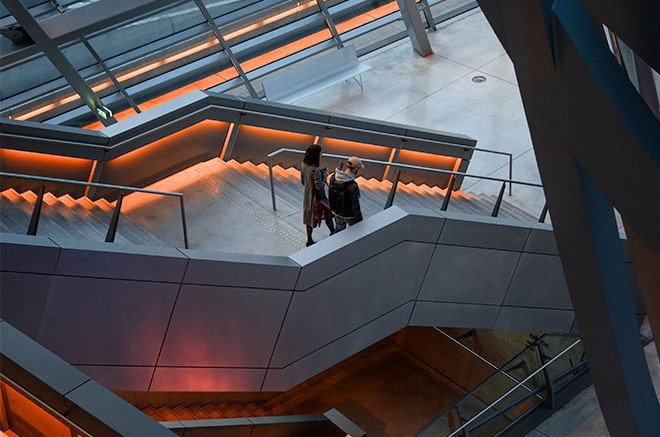How individual buildings support collaboration within an urban environment
Published on 22nd April 2021
Our series exploring how buildings contribute to the 'smartness' of city environments considers the role of collaboration

Individual buildings can contribute to the digital, sustainable and green 'smartness' of a smart city, but this requires collaboration – indeed, this is a third essential element that drives the smartness of the urban environment. Flexibility in the way the building is constructed and used drives the extent to that it can be managed and operated in a collaborative manner: the two are closely intertwined.
Mixing up urban activities
Although many cities have traditionally been zoned for particular activities – such as for retail, business or residential – this can end up creating areas that are not well used at particular times of the day. Revenues generated by individual buildings, as well as community benefits and the green consideration of efficient use of constrained resources (that is, space) may all be reduced as a consequence.
If a city is designed from the ground up, there are extensive benefits to mixing up activities and uses within particular areas. One manifestation of this is the "15 minute city" approach that cities such as Paris have adopted. A shift to mixed urban uses within a particular area may well require greater flexibility in change of use authorisations for individual buildings, with potentially a shift in planning policy to enable it (also discussed in this series).
The coronavirus pandemic may turn out to be a driver of this type of rethinking. The necessity of mass adoption of remote working has caused many to reassess work as an activity rather than a location. As a consequence, the logic of commuting is shifting, and urban centres may decentralise. Tenants may settle into new patterns of occupancy. This impact of this shift is being felt particularly strongly in urban business districts, where office real estate predominates. While weekend emptiness has historically been offset by the intensity of activity and density of use from Monday to Friday, greater remote working and lower weekday concentrations may upset this balance going forwards.
Mixing up tenants
Mixed use could be across a city area, or within an individual building. A "smart" building might be one that is managed in a flexible way to make sure all parts of it are well used at all times of the day – which would also maximise revenues, creating a commercial incentive for the change of approach. A building might have mixed use designed into it, perhaps combining ground floor retail or restaurant use with offices on middle floors and residential space at the top.
Alternatively, buildings used during the day might be opened up for access by others in the evening or at night. Perhaps office catering facilities might be used as a "dark kitchen" for evening takeaway or as a community restaurant; meeting rooms or an in-house gym might be a useful facility for the local community in the evenings; local residents might be able to use an office's electric vehicle charging infrastructure overnight. However, if an urban district is primarily focused on one activity – retail or offices, for example – it may be difficult to find demand for the facilities outside office hours. With a bigger mix of land use in a locality, the chances of multifaceted demand for space across a 24-hour period are increased.
Designing for flexibility
Design features in a building can enhance or reduce flexibility in how it is used. Mixed use could be constrained if a building is designed for a single occupant – for example, with a large open atrium at the heart of the design. Partitioning floorplates for multiple occupants becomes awkward in such a building, and lifts and toilets might not be located so that they are accessible if a floor is divided up.
Shared office-space providers are leading the way in designing and managing space with multiple occupants. Concerns such as confidentiality are managed through the set-up of the shared spaces. Flexibility of use requires smart planning of the initial design and fit-out of the space to create the potential for various uses.
| Interested in hearing more from Osborne Clarke? Register now for more insights, news and events from across Osborne Clarke > |
Technology supporting collaboration
Technology can make the process of identifying potential demand to share a space much easier. Digital platforms can create transparency about the availability and location of available space, matching supply to demand and potentially managing payment etc. This is already seen, for example, with online platforms advertising the availability of short term "pop-up" retail space, or the systems used to book shared office space. Many landlords already have tenant engagement apps for individual buildings that might be built out and opened up to neighbouring organisations to let them book spaces that are opened up, generating new revenues or community benefits. But, as discussed earlier in this series, a patchwork of siloed digital systems limits the wider benefits: the more that such platforms and systems are interoperable and interconnected, the broader and wider will be the benefits that can flow from them.
Data-gathering technology can be used over time to understand demand, which can feed into financial modelling, design of new buildings or refits, and understanding more generally about which community benefits are the most in demand and how best to facilitate them.
Liability and risk
As is clear from the examples discussed above, a shared, collaborative approach to buildings can generate significant community benefits and boost the smartness of how a city operates. Of course, liability, risk, and insurance arrangements will all need to be considered between the stakeholders in the building. There are various ways in which risk could be structured to enable a collaborative use of premises. A landlord could, for example, elect to have one anchor tenant taking responsibility for the building as a whole and for managing multiple/layered use (with appropriate permissions in the head lease).
The particular risk profile and legal situation will depend on the focus of the shared use. Where strangers are being given access to property, risk is being increased without corresponding control over the new occupants. This could involve additional security costs. Care is needed in this respect, particularly where activities might be regulated. The example of sharing electric vehicle charging facilities needs care to ensure that the owner, tenant or manager is not considered to be an energy retailer supplying energy to third parties, which requires a licence under energy regulation.
A collaborative approach to operating a building may mean that the financial modelling for managing it includes revenues or costs savings based on sharing access, mixing use, or collaborating with others to pool utilities management (as discussed in our green smartness article). This may drive rent levels or fees for access etc. If the modelling includes agreed assumptions, but actual levels fall below those assumptions, it will be necessary to consider how the revenue risk is shared. Insurance might offer a hedge, or tapers might be worked into the contract to deal with this issue.
Flexible, shared occupancy is likely to require landlord consent but, more generally, a new approach to real estate asset management. If long-term rents are the main revenue stream under a lease then there is little incentive on the landlord to enable this new approach. But if overall revenues could be shown to be greater with flexible, multiple layered occupancy, perhaps with a revenue share arrangement to incentivise the landlord to enable it, assumptions could change. The real estate sector is only just realising how agile they need to be as urban use of property changes.
This infographic summarises our approach to smart cities. If you would like to discuss any of the issues raised in this article or in our infographic, please contact one of the authors or your usual Osborne Clarke contact.





